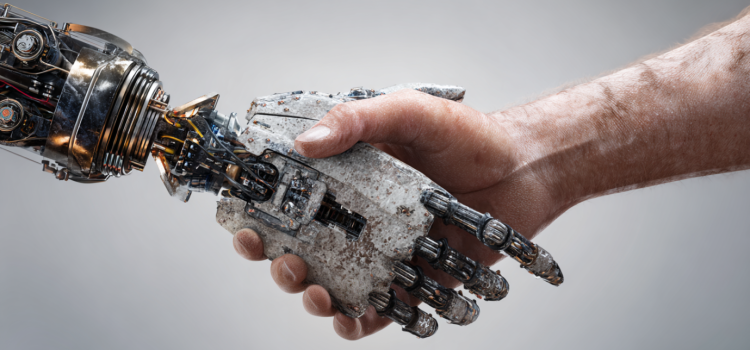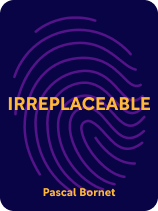

This article is an excerpt from the Shortform book guide to "Irreplaceable" by Pascal Bornet. Shortform has the world's best summaries and analyses of books you should be reading.
Like this article? Sign up for a free trial here.
How can you remain relevant in a future of AI? What human capabilities can’t AI replicate? How can you use AI to your advantage rather than your detriment?
As artificial intelligence rapidly transforms our world, many of us wonder how to remain relevant in an automated future. In Irreplaceable, Pascal Bornet tackles this question. He explains that as AI spreads, our success will lie in learning to work with it—by augmenting our distinctively human strengths with this powerful technology.
Keep reading for an overview of Bornet’s book.
Irreplaceable Overview
You’ve probably heard the doom and gloom about AI—but what if the naysayers are wrong? According to Pascal Bornet, author of Irreplaceable (2023), AI isn’t a threat to humanity but a profound opportunity to become more fully human. With its powerful computational capacities and rapid pace of advancement, AI will inevitably outdo people at definable, automatable work. But that’s okay, because it leaves for us the work that naturally makes us feel most alive: thinking and reasoning clearly, expressing our creativity, and connecting with and leading others.
The key is to work with AI rather than resisting it. Bornet, a former McKinsey executive and automation consultant for 20+ years, says that we can let AI handle rote computational work (where it beats us) while we do the inventing, strategizing, communicating, and leading—all the undefinable, freeform human work that AI can’t replicate. After introducing his basic premise that AI is sticking around and will automate away many jobs, we’ll cover Bornet’s three core strategies for navigating these coming changes:
- Become adaptable—learn how to adapt properly for the AI age
- Become more human—learn how to leverage your distinctively human strengths
- Become AI-augmented—learn how to use AI in your work and at home
In our commentary, we’ll discuss the history of AI as well as its impact, varieties, and trajectory. We’ll also relate Bornet’s ideas to the work of experts like Gary Marcus and Ernest Davis (Rebooting AI), William B. Irvine (The Stoic Challenge), and Cal Newport (Digital Minimalism).
AI Is Already Advanced and Advancing
Right off the bat, Bornet asserts that AI is here and will almost certainly take your job. But if you play your cards right, this is an opportunity to evolve as a person and a professional (we’ll cover how to do this later). In this section, we’ll explain how AI has already begun doing jobs we thought humans would always be better at. We’ll also explore how the rapid advancement of technology means more automation is coming.
The AI Revolution’s Speed
Bornet says that AI isn’t a fad—it’s a revolutionary technology that will change everything about how we live and work. However, the AI revolution differs from previous technological shifts in a few ways. First, its speed is unprecedented: While previous revolutionary technologies like electricity or computers took many years to mature, AI capabilities are now leaping forward in periods of weeks and months. Just consider that while decades of research went into creating the first large language models (LLMs), new and more capable models now emerge multiple times a year. According to Bornet, this exponential rate of change means that in a decade or so, AI will become many times more advanced than it is today.
The AI Revolution’s Impact
Second, AI’s impact will be more wide-reaching than that of other technological shifts. It’s more like the discovery of electricity than the invention of electrical appliances, yet will be still more transformative. This is because AI affects everything from basic work tasks (like emails and taking meeting notes) to specialized professional work (like marketing and business strategy). Already, AI powers everyday tools like GPS and smart homes. It’s also used in some fields like medicine and law—areas once thought immune to automation.
Bornet says that given the speed and breadth of the AI revolution, your current job will likely be automated away or otherwise transformed by AI. This isn’t speculation—it’s already happening across various industries. Beyond medicine and law, AI automation has reached work like data entry and analysis as well as finance and trading. Jobs dealing with creative work like writing, design, and coding are also being augmented with automation.
Strategy #1: Become Adaptable
If AI is here to stay and only getting better, how can we capitalize on this opportunity? According to Bornet, your best bet is to use three strategies that will make you indispensable. In this section, we’ll cover his first strategy—becoming properly adaptable for the AI age. This involves understanding how artificial intelligence differs from human intelligence, and what these differences tell us about how to work with, rather than against, AI.
Human Intelligence versus Artificial Intelligence
What do humans do better than AI, and vice versa?
Bornet explains that artificial intelligence excels at well-defined computational work. It can process huge amounts of information with ease and speed. It can also perform complex and repetitive computational tasks, like identifying trends in massive datasets or drafting documents. AI does best when these tasks have clear, objective rules and parameters—like flying an airplane from point A to point B. However, AI struggles to perform tasks it hasn’t been trained to handle. It relies on humans to clearly define its work.
In contrast to AI, human intelligence excels at self-driven adaptation and learning. Where AI depends on being trained and fed data, humans evolved over millennia to proactively engage with and learn about the world around us. This was crucial for our survival, and through it we evolved to have emotions, learn from lived experience, have intuition and a sense of ethics, and understand context. Bornet writes that all of this contributes to human autonomy and a fullness of being that AI lacks.
This ability to evolve and grow of our own accord means that unlike AI, humans can excel at complex work defined by ambiguous rules or parameters. As proactive problem-solvers, we can apply our existing knowledge in new ways and learn more from doing so. For instance, a writer learning graphic design might see parallels in how both disciplines use composition and patterns to communicate clear messages.
While humans beat AI at self-driven, proactive adaptation, we’re also vulnerable to cognitive biases—errors in our thinking or reasoning. And we get tired, whereas AI doesn’t.
Continually Learn and Adapt
Bornet writes that because AI beats us at computational tasks while we beat AI at proactive adaptation, the best way forward is to work together. Our strengths and weaknesses naturally complement one another. So, we should delegate to AI the work it’s naturally better at while saving our bandwidth for what we’re naturally better at.
However, AI will continue advancing as time goes on, and there will be disruptions to any AI tools we get used to. For instance, LLMs were popular in 2023-2024, but now AI agents are taking over. Therefore, to effectively partner with AI, we need to prepare for ongoing change. To do so, make a mindset shift: Choose to view change and disruption, however difficult, as a catalyst for your growth. This will allow you to adapt to any change.
Bornet makes three key recommendations for becoming more adaptable:
1) Be flexible: Stop thinking in terms of “jobs” and focus instead on your transferable skills. As the world changes, your list of past job titles will become less important than the skills you develop and carry between workplaces. Treat any job foremost as a chance to gain experience in a variety of skills, building general professional competence rather than pigeonholing yourself into one specialized career path.
2) Get resilient: Develop the habit of recentering yourself amidst emotional turbulence and disruption. Recognize that life will soon become a continuous process of upheaval and change, and learn to dig deep into your emotional reserves so you can handle anything.
3) Keep learning: Bornet contends that technical skills and knowledge have shorter lifespans than ever. Instead of specializing, become good at learning itself. If you can skillfully learn, you can adapt to any changes and thereby remain relevant as AI improves.
Strategy #2: Become More Human
Readying yourself to continually adapt is one thing—the next step is developing your key human strengths. As we explained earlier, humans are better than AI at open-ended work that involves ambiguity and unclear boundaries. In this section, we’ll dive deeper into the capabilities that make us distinctively human—creativity, critical thinking, and connection.
Capability #1: Creativity
Bornet asserts that current AI technology can’t compete with genuine human creativity. That is, AI can produce the appearance of creativity, but the appearances it produces lack real depth—they’re only a form of mimicry. This is because generative AI models (like ChatGPT) work by predicting the most probable next element based on statistical patterns learned from vast datasets. The model doesn’t truly “create” like a human does—it makes statistical predictions about what should come next in a given sequence of elements (like words or pixels). These predictions create things that accurately resemble human-made works, but which lack their emotional evocativeness, substance, or depth, according to Bornet.
For instance, say you ask ChatGPT to “write a short story in the style of Ernest Hemingway.” To do so, it’ll reference the billions of patterns it’s been trained on to predict a more or less appropriate sequence of words for that prompt. But it doesn’t know what any of Hemingway’s writing means, so the output will look like his work but lack its substance.
In contrast to AI’s statistical mimicry, humans can be truly creative. Bornet writes that this is because true creativity comes from lived experience. To create, a human draws on their personal experiences, emotions, and intuition—their unique sense of what’s meaningful. They channel that into their work, imbuing it with intention and feeling that evokes emotional responses in others. Their work is meaningful because it speaks of and from their personal lived experience. This distinguishes their work—say, a song—from an AI version that sounds just like it. Bornet says that because AI isn’t alive in a world of emotion, meaning, and context, it can’t and won’t ever be able to create as humans do.
If you want to develop your creativity, Bornet recommends that you practice mind-wandering. Instead of reaching for some entertainment, let yourself be bored during moments of daily downtime. This stimulates your mind to wander freely and make unusual associations. In turn, this encourages creative insights or ideas, since your mind can go in any direction and connect thoughts it normally wouldn’t. You can also encourage this sort of free-associative thinking by going for walks in nature and by slowly falling asleep or waking up without your phone nearby.
Capability #2: Critical Thinking
Next, Bornet explains that humans can think critically in ways that AI can’t. Critical thinking means using reasoning skills to scrutinize information and come to sensible, well-informed judgements. This involves identifying and questioning any premises, assumptions, and biases in context to learn and improve your understanding.
For instance, imagine you’re a new business owner selling candles online, and you see a dip in revenue during your first summer. You’ve been running a sale on new summer scents, but it hasn’t brought the returns you’d hoped for. To think critically about this, you reflect on the reasoning behind your decision as well as relevant information like market data. In the end, you find out that people don’t buy as many candles in the summer—something you’ll keep in mind for the future. This thinking process requires the ability to consider context and nuance, which AI struggles to do. It also asks you to think about your own thinking, another capacity AI lacks.
One key step Bornet recommends for thinking more critically is to learn about cognitive biases. These are built-in errors, or “glitches,” in our thinking. We’re all vulnerable to them, and they affect our thinking on an unconscious level. Start by learning about the most common cognitive biases (like hindsight bias—where we believe after the fact that we “knew something all along”). By becoming more conscious of these biases, you can avoid falling prey to them.
Capability #3: Connection
The third AI-proof skill is connection. According to Bornet, connection is the ability to authentically relate with other humans to build relationships, empathize, collaborate, lead, and more. He says these activities will remain automation-proof because AI lacks flesh-and-blood lived experience, so it can’t relate to humans with real emotion or understanding.
Bornet says that our ability to connect with one another involves three distinct abilities: emotional intelligence, communication, and leadership.
Emotional Intelligence
The first ability, emotional intelligence, is being able to feel and understand your own emotions and those of others. Emotional intelligence helps you form real and lasting relationships because everybody wants to feel seen and understood.
Communication
The second ability is communication, which means more than just talking to people. Human communication involves speech, non-verbal social cues, and awareness of cultural contexts and emotional subtexts. While people can communicate on all these levels, AI can’t.
Leadership
The last ability is leadership, which Bornet defines as being able to guide, inspire, and influence others for the better. This relies on both emotional intelligence and communication skills. Leaders navigate complex interpersonal dynamics to coordinate and inspire groups of people to collaborate on large projects.
How can you begin building these connection skills? According to Bornet, you can learn to better connect with people by learning to empathize. He suggests practicing active listening, opening yourself to different perspectives, and becoming more sensitive to the many differences among various kinds of people. This will help you create inclusive spaces where people feel seen and included.
Strategy #3: Become AI-Augmented
So far, we’ve covered how adaptability and humanity are your two key assets in the AI age. With that groundwork laid, let’s turn to Bornet’s advice on how to partner effectively with AI. As we explained earlier, human intelligence and artificial intelligence have distinct strengths and weaknesses. Because of this, humans and AI can do more together than we can alone. For instance, in a chess tournament, human-AI teams beat both human professionals and solo AI players. In this section, we’ll explain how to leverage this effect at work and how to avoid becoming too reliant on modern technology (including AI).
Exploit AI’s Upsides at Work
Bornet writes that to use AI well, you need to think differently about work. Specifically, he recommends focusing on efficiency and the creation of value instead of long hours, busyness, and constant effort.
Work culture has traditionally valorized tireless productivity. But with AI, this will no longer be necessary because we can automate a lot of our busywork, like drafting marketing emails or internal memos. This leaves us with more time to slow down, collaborate, reflect, and live balanced lives. In the long run, this will be better for us and our work.
Given the potential for AI to improve our work, the next step is to become AI literate. To do this, spend a portion of your work hours reading and learning about AI. Bornet says you don’t need to have world-class technical knowledge of AI, but you should know the basics of how it works. You should also stay up-to-date with recent developments, like new generative AI models or training techniques. This will help you bring useful new ideas into your workplace.
Alongside your efforts to learn about AI, start using AI to automate some of your activities at work. Bornet says that the best activities to automate are rote, rule-based, formulaic processes that have few exceptions to how they operate. For instance, a business owner might implement an AI tool to automate email responses to a set of common, repetitive customer questions that don’t need tailored replies. However, be sure you understand these processes yourself before you automate them. That way, you can fix them if something goes wrong with the AI.
Bornet offers a four-step strategy for implementing AI automation at work:
- Step 1: List and sort your work activities to identify those that consume the most time and yield the least value, as well as those that consume the least time and yield the most value. You’ll automate the former to free up time for the latter.
- Step 2: Standardize the work you’ll automate by breaking it down into a detailed set of steps. For instance, thoroughly define the steps AI would follow to successfully run monthly payroll. Refine the steps to ensure they work before implementing them.
- Step 3: Find an AI tool that fits your needs and run a small-scale trial with it. For instance, you might implement payroll automation on just a small portion of your company. Make sure it works on a small scale first.
- Step 4: Slowly scale up your AI automation, adjusting as you go. Say the above payroll automation worked for the C-suite—next, implement it for one additional department or team at a time. Monitor how it works and fix problems as they arise.
Avoid the Downsides of Modern Tech
Last, Bornet stresses that you should avoid overusing modern technologies, including AI. Many modern digital technologies, like social media, encourage us to overuse them. For all its potential for good, AI also carries this risk. This is because its powerful responses provide a sort of instant gratification—send a few prompts, then get an image created or an article written in a snap. If we use this power unthinkingly, we risk becoming dependent on it and forgetting how to do things ourselves (like write, code, paint, or make music). To avoid falling prey to tech and AI overuse, follow these guidelines:
- Don’t use AI for anything that would give you joy. Instead, treat it as a tool for reducing arduous, rote work—not something to make your whole life more convenient. For instance, do your own drawing, creative writing, or music making.
- Set boundaries around your tech use. Schedule times for using your phone, whether for email, social media, or browsing. Also schedule times to put your tech away and focus on being present where you are, in the real world.
- Clean up your digital presence. Share only essential data and make sure you trust the organizations you give it to. Review your privacy settings regularly, and don’t be afraid to request that your information be deleted from accounts you no longer use.
Bornet clarifies that moderation doesn’t mean rejection. Don’t avoid using AI or technology entirely. Rather, be intentional and strategic about how you use it, and always make space and time for genuine human connection, real-world experiences, and enjoyment that doesn’t depend on technology.
Exercise: Identify Your Human Strengths and Weaknesses
Reflect on which of Bornet’s key human skills you feel strongest and weakest in, and plan a few steps for developing them further.
- First, identify which of the three skills (creativity, critical thinking, or connection) you feel strongest in. Describe specific instances where you’ve demonstrated this strength. For example, if you excel at critical thinking, you might recall a time when you successfully analyzed a complex problem and found an innovative solution.
- Next, consider which of these skills is your weakest. What specific difficulties do you encounter when trying to use it? For instance, you might struggle with connection because you find it hard to read emotional subtleties in professional situations.
- Think of one way you could improve at your weakest skill. For example, if it’s connection, you could practice conversation at a Skip the Small Talk event. If it’s critical thinking, you could practice evaluating your decision-making for biases.
- Last, think of how you can capitalize on your strongest skill. Taking the example of creativity, you might bring some outside-the-box ideas to your workplace and see if you can help spur new product or service ideas.

———End of Preview———
Like what you just read? Read the rest of the world's best book summary and analysis of Pascal Bornet's "Irreplaceable" at Shortform.
Here's what you'll find in our full Irreplaceable summary:
- How we can prevent AI from replacing us by working with it instead of against it
- Strategies for becoming indispensable amidst ever-improving AI technologies
- The four-step process for implementing AI automation at work







waiting for Bornet’s take on PO POAI and POPO and whether or not E = mc2 = LOVE is a catalyst to having humans understand the feeling of “giving”.